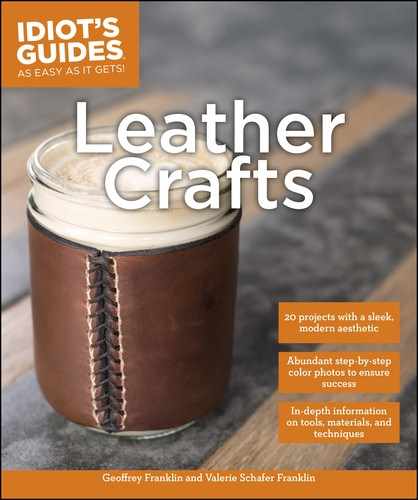
Tool Roll
Every job is easier if you keep all the right tools in the right place, whether it’s knitting needles, bike mechanic tools, manicure kits, or chef’s knives. This tool roll is designed to fit small tools and the closure belt doubles as a strap to secure it to a bike saddle or backpack.

Finished size
5½×14 inches (14×35.5cm)
Materials
1 piece 2–3 ounce (0.8–1.2mm) vegetable-tanned leather, 7½×17 inches (19×43cm)
1 piece 4–5 ounce (1.6–2.0mm) garment leather, 7×4 inches (17.8×10.2cm)
1 piece 6–7 ounce (2.4–2.8mm) vegetable-tanned leather, 5/8×14 inches (1.6×35.5cm)
Double cap rivet, 1¼ inches (0.6cm)
Bar buckle with roller, 1¾ inches (2cm)
Cement
5-strand waxed nylon thread
Template
Tool Roll (idiotsguides.com/leather)
Tools
Chipboard
Mechanical pencil
Precision knife
Straightedge
Cutting mat
Strap cutter
Latex gloves
Fiebing’s oil dye, dark brown
Fiebing’s Bag-Kote (gloss)
Makeup sponge
Clean rags
Spray bottle
Scrap wood board
Adjustable stitching groover
Multi-prong pricking iron
Mallet
Clamps
Awl
English point end punch, 5/8 inch (1.6cm)
Bag punch, ¾ inch (2cm)
Hole punch, #2
Hammer
2 harness needles, #00
Techniques Used
Working with Templates
Cutting
Finishing Leather
Edge Finishing: Edge Dyeing
Punching
Hardware: Riveting
Hardware: Attaching a Buckle
Hand Stitching
Cementing
Shaping Leather: Folding
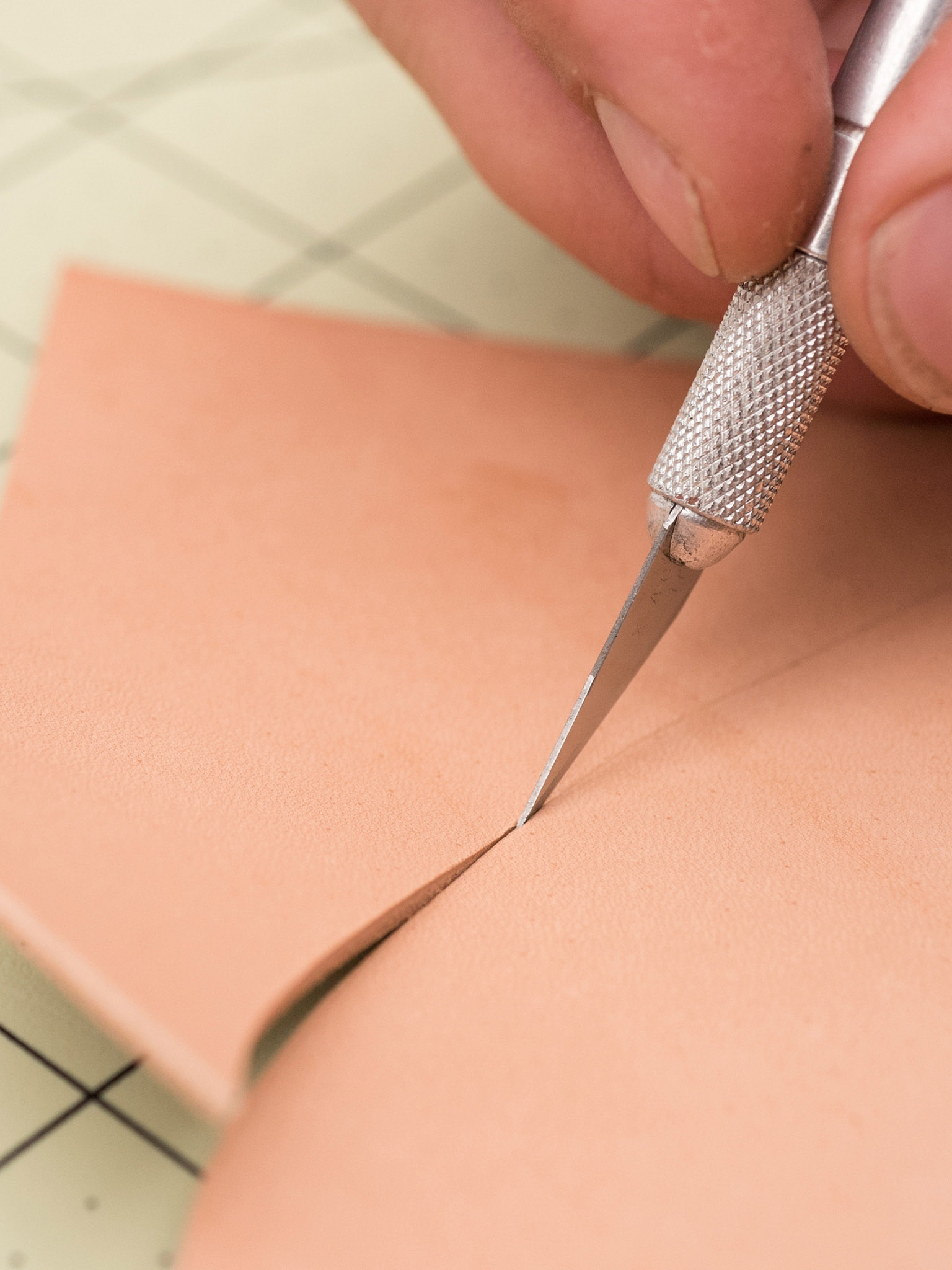
1 Trace the template and cut the leather. Transfer the template pattern to chipboard and cut it out. Trace the template onto both the 2–3 ounce vegetable-tanned and the garment leather, as indicated. Cut out each leather piece using the precision knife and straightedge.

2 Cut the belt. Set the strap cutter to 5/8 inch (1.6cm) and cut a strap of the 6–7 ounce vegetable-tanned leather at least 14 inches (35.5cm) long.

3 Trace and cut the belt template. Trace the belt template to the strap cut in Step 2 and cut to length using the English point end punch and precision knife. Punch holes where marked using the #2 hole punch and bag punch.

4 Dye the edges. Using a makeup sponge, carefully apply oil dye to the edges of both pieces of vegetable-tanned leather.

5 Dye the leather surfaces. Using a small rag, rub oil dye over the front surface of the vegetable-tanned leather pieces—both the project body and belt strap. Allow at least an hour to dry before proceeding to the next step.

6 Gloss the dyed surfaces. Using a clean rag, rub gloss over the front surface to finish and protect the hand-dyed leather. Allow time to dry—at least six hours or overnight—before proceeding to the next step.
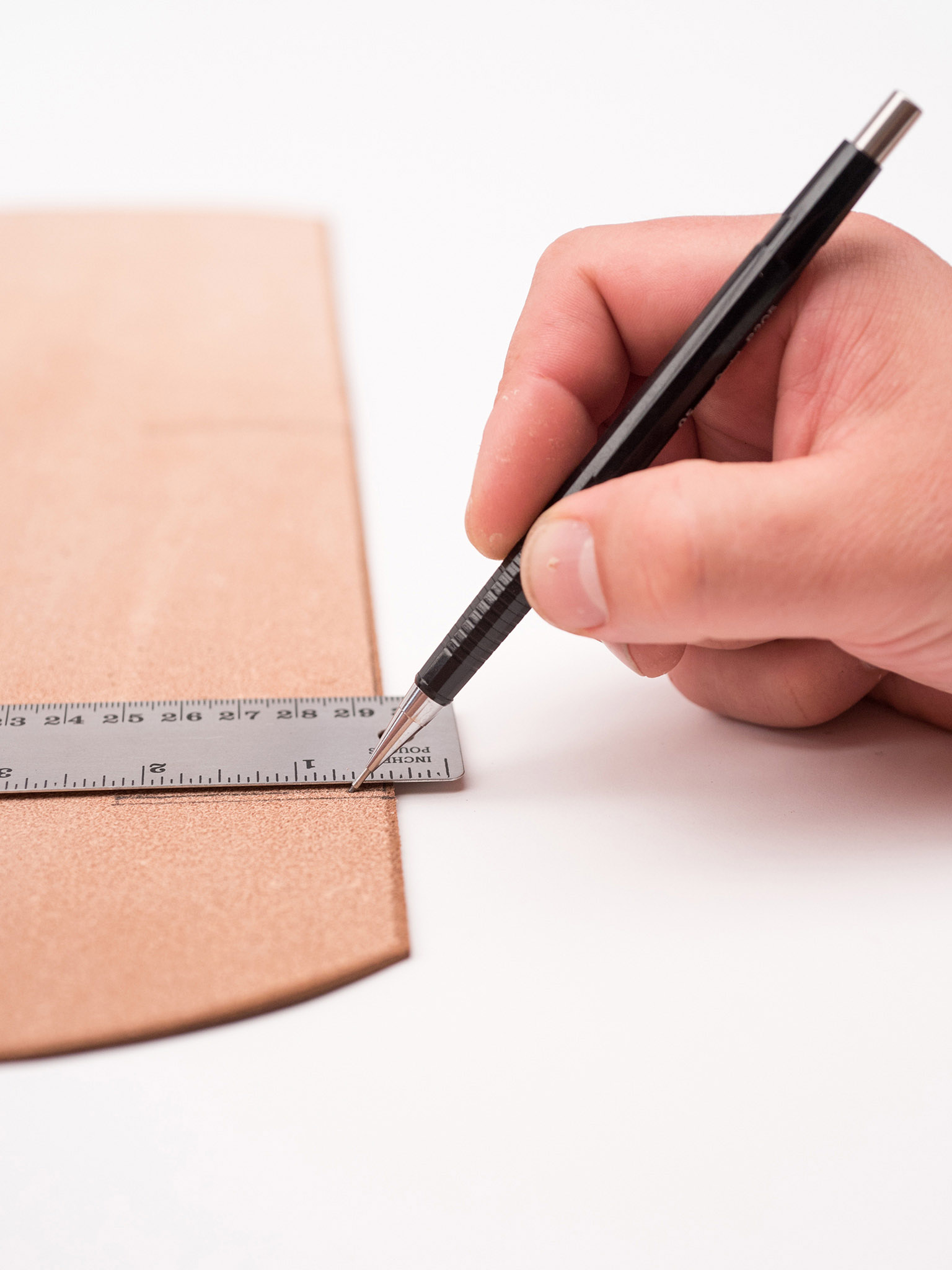
7 Measure and mark the fold line. Reverse the project body (the large piece of 2–3 ounce vegetable-tanned leather) and draw the fold line on the rough side using a mechanical pencil, as shown on the template.

8 Measure and mark glue lines. Measure and mark the glue lines for the fold-over pocket, tool pocket, and tool flap on the rough side of the project body and garment leather, using a mechanical pencil, as shown on the template.

9 Cut the stitch grooves. Using the adjustable stitching groover, mark the stitching guide line on the finished surfaces of the garment leather, ⅛ inch (0.3cm) from the edge, as shown on the template.

10 Mark and punch holes. Mark and punch the oval-shaped holes using the bag punch in the project body, as shown on the template.

11 Attach the buckle to the strap. Using the double cap rivet, attach the buckle to the dyed and glossed belt strap.

12 Mist the fold line. Mist the rough side of the leather at the fold line on the bottom of the project body.

13 Clamp and let dry. Fold the fold-over pocket, making sure that the sides are straight and aligned before creasing. Clamp the scrap wood board to the fold to ensure even pressure and a stiff, straight fold line. Let the project dry in the clamp.

14 Cement the fold-over pocket glue lines. Apply a thin coat of cement ⅛ inch (0.3cm) wide to the glue lines at the bottom of the project body, marked in Step 8. Allow the cement to dry for about 30 seconds before beginning the next step.

15 Adhere the fold-over pocket. Fold the leather in half lengthwise at the fold line, paying careful attention to line the edges up flush with each other. Hold for a few seconds and place under a book or heavy object to dry for at least 5 to 10 minutes.

16 Prepare the fold-over pocket for stitching. Using the stitching groover, cut grooves for stitching ⅛ inch (0.3cm) from the edges of the fold-over pocket, as shown on the template.

17 Punch the stitch holes. Using the multi-prong pricking iron, punch the stitch holes evenly along the two stitch grooves.

18 Stitch the fold-over pocket. Place the project in the stitching horse and open each stitch hole with the awl. Hand stitch the sides of the fold-over pocket using a saddle stitch and tie off.

19 Cement the tool pocket. Apply a thin coat of cement ⅛ inch (0.3cm) wide to the glue lines marked in Step 8 on the reverse side of the garment leather tool pocket and the side of the project body, as shown on template.

20 Adhere the tool pocket. Press the two glued sides of the tool pocket together and allow to dry.
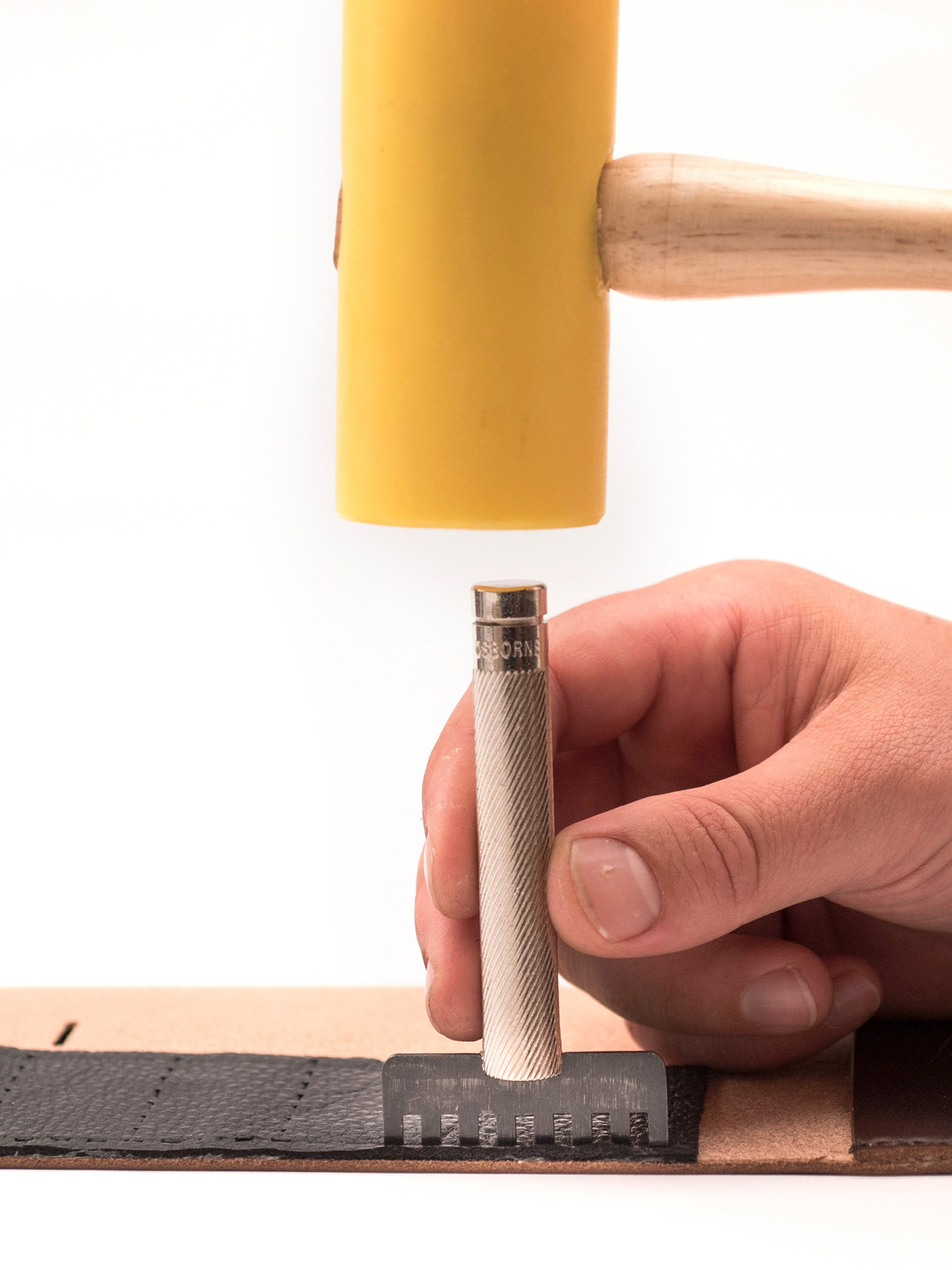
21 Prepare the tool pocket for stitching. Using the multi-prong pricking iron, punch the stitch holes evenly along the glued sides of the tool pocket and the interior tool dividers, as shown on the template.

22 Stitch the tool pocket. Hand stitch the garment leather tool pocket to the vegetable-tanned project body using a saddle stitch. Begin stitching along the glued lines first, followed by the interior pocket dividers. Tie off.
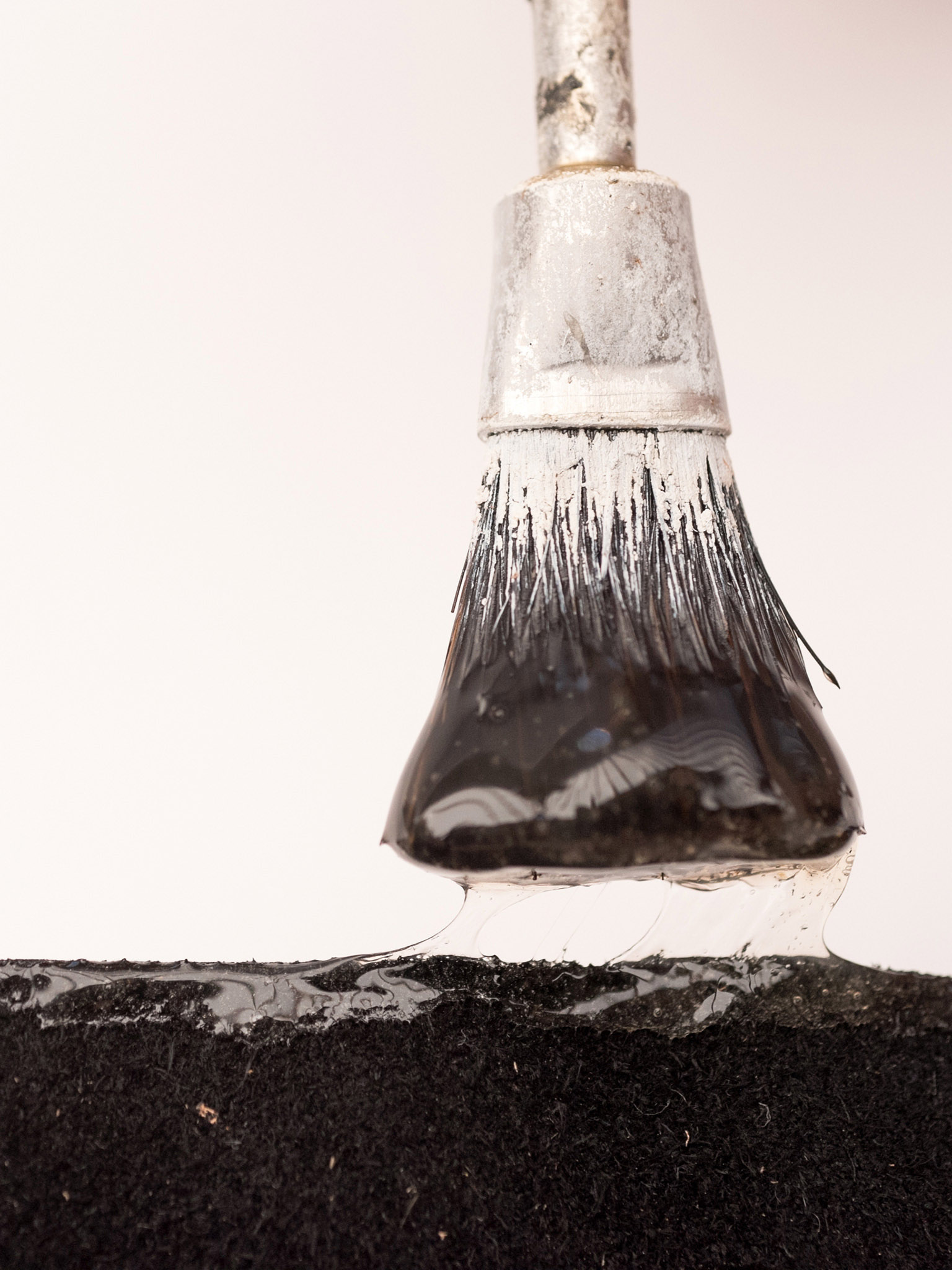
23 Cement the tool flap. Apply a thin coat of cement ⅛ inch (0.3 cm) wide to the glue line marked in Step 8 on the reverse side of the garment leather tool flap and the other side of the project body, as shown on the template.

24 Adhere the tool flap. Allow the cement to cure for approximately 30 seconds before pressing the two glued sides of the tool flap together. Allow to dry at least 5 to 10 minutes.

25 Prepare the tool flap for stitching. Using the multi-prong pricking iron, punch the stitch holes evenly along the glued side of the tool flap, as shown on the template.

26 Stitch the tool flap. Hand stitch the garment leather tool flap to the vegetable-tanned project body using a saddle stitch, and tie off.

27 Assemble the tool roll. Thread the pointed end of the belt in the top flap of the tool roll through the first bag punch hole and weave through the bag punch holes. Roll it up and buckle the belt to hold the tool roll together.
With these basic techniques, you can customize the size of the tool roll to fit your needs. Widen the project body or add extra interior tool pocket dividers to create a custom tool roll for wrenches, artist’s supplies, or whatever you need to organize.

